初中英语非谓语动词用法归纳
英语非谓语动词用法总结

千里之行,始于足下。
英语非谓语动词用法总结非谓语动词是英语中一种特殊的动词形式,它们没有主语,也没有时态的变化。
非谓语动词分为不定式、分词和动名词三种形式。
它们在句子中可以充当动词、形容词或名词的作用,用来修饰或补充主句的内容。
非谓语动词用法灵活多样,可以用在主句的前面、后面或中间位置,并且可以与其他成分同时存在于一个句子中。
在本文中,我将总结非谓语动词的用法,并给出一些例子来帮助理解。
一、不定式(infinitive)1. 不定式作主语e.g. To learn English is my goal. 学英语是我的目标。
2. 不定式作宾语a) 动词后直接接不定式作宾语e.g. I want to go to the cinema. 我想去电影院。
b) 动词后接代词(宾格)+不定式作宾语e.g. She advised me not to buy that car. 她建议我不要买那辆车。
3. 不定式作宾语补足语e.g. I found it hard to understand his accent. 我发现很难理解他的口音。
4. 不定式用来表示目的e.g. I went to the library to borrow some books. 我去图书馆借书。
5. 不定式用来表示结果第1页/共3页锲而不舍,金石可镂。
e.g. She was too tired to continue working. 她太累了,无法继续工作。
6. 不定式用来表示原因e.g. He called me to apologize. 他打电话给我道歉。
7. 不定式用来表示方式e.g. She danced gracefully to the music. 她优雅地随着音乐跳舞。
二、分词(participle)1. 现在分词(-ing形式)a) 分词作定语,修饰名词e.g. The running dog is mine. 那只奔跑的狗是我的。
初中非谓语动词用法的几点归纳

初中非谓语动词用法的几点归纳:非谓语动词是英语学习中非常常见的语法点,它的几点用法现归纳如下:一.构成:to do, not to do二.用法:1.作主语(不定式作主语时,常用it代替不定式作形式主语放在句首,把不定式放在句末)It is/was +adj.(for sb) to do sth.To study hard for us is important.=It’s important for us to study hard.It’s not easy to le arn English well.Is it necessary for us to learn to wait?It’s good for us to take more exercise every day.2.作宾语I hope to see you soon.He wanted to answer this question.Jack wishes to do this by himself.He would like to help you.I like to watch TV.3.作宾语补足语Our teacher asked us to stop talking.Tell him to wait a minute.He wants his father to buy a new bike for her.Would you like me to go instead of you?He made them work 12 hours a day.Let me help you .I heard her sing last night.4.作表语His job is to sell bikes.Her wish is to be an actress.His dream is to become a doctor.5.作定语(放在所修饰词的后面)I have a bit of homework to do every day.He has nothing to do.Give me something to eat.He is looking for a room to live in.Pass me a piece of paper to write on.He always has something to complain about.6.作状语I’m sorry to hear that.I’m afraid to see her.He is too young to go to school.He’ll go to visit his uncle.He came to say goodbye to us.They stopped to have a look.He is tall enough to reach the top of the door.三.不定式短语的形式1.to do +宾语We are happy to help you.2. for sb to doIt’s easy for us to get lost in the forest.3. 特殊疑问词+to doI want to know when to leave.He doesn’t tell us what to do next.Can you tell me how to go there?Tell me where to find Jim.四.注意几点:1.make/let/ listen to/look at/ hear/see/watch /have/help 后的动词不定式, 不用to. Listen to LiMing sing a song,please.He often makes/has us laugh in class.Don’t let him sit down.2如果两个以上的不定式并列时,除第一个不定式外,其余的须省去但两者是对比关系的不能省。
初中英语知识点归纳动词的非谓语形式

初中英语知识点归纳动词的非谓语形式动词的非谓语形式指的是动词在句子中充当非谓语成分的形式,包括动名词、不定式和分词。
在初中英语中,学习和掌握这些非谓语形式对于理解句子结构和扩大语言表达能力非常重要。
下面将对初中英语中常见的动词的非谓语形式进行归纳总结。
一、动名词 (Gerund)动名词是动词变形后构成的名词,常常用作主语、宾语或介词的宾语。
1. 动词 + -ing如:swimming, playing, reading等2. 主动形式的不定式– to + 动名词如:to swim, to play, to read等3. 情态动词 + 动词原形 + -ing如:can't help doing, enjoy doing, keep on doing等动名词的用法:1. 作主语用动名词作主语可以使句子更加简洁明了。
如:Swimming is my favorite sport. (游泳是我最喜欢的运动。
)2. 作宾语一些动词后常接动名词作宾语,如:enjoy, finish, quit, suggest等。
如:I enjoy reading books. (我喜欢读书。
)3. 作介词的宾语一些介词后常接动名词作宾语,如:at, for, in, on等。
如:She is good at singing. (她擅长唱歌。
)二、不定式 (Infinitive)不定式是动词的一种形式,常常用作动词、形容词或副词的补语。
1. 动词原形 (to + 动词原形)如:to swim, to play, to read等2. 情态动词 + 动词原形如:can, may, must等不定式的用法:1. 作主语用不定式作主语可以使句子更加简洁明了。
如:To learn English well is my goal. (学好英语是我的目标。
)2. 作宾语一些动词后常接不定式作宾语,如:want, plan, hope等。
初中英语语法之非谓语动词

初中英语语法之非谓语动词1.定义:动词除在句子中作谓语以外,还具有名词、形容词及副词的性质,在句中可作主语、表语、宾语、定语、状语和补语等,这就是动词的非谓语动词。
可分为三种:动词不定式、分词和动名词。
2.动词不定式:to + 动词原形。
1)一般式:主动语态:to do ,被动语态:to be + 动词过去分词2)进行式:主动语态:to be doing ,被动语态:无3)完成式:主动语态:to have +动词过去分词,被动语态:to have been +动词过去分词4)用法:A. 作主语:To learn a foreign language is not easy . = It’s not easy to learn a foreign language .B. 作表语:The most important thing is to finish the workon time .C. 作宾语:a. 动词+to do . He decided to buy a new watch .b. 动词+疑问词+to do I don’t k now where to put thebike .c. 动词+形式宾语+宾补+to do I find it important to learna second foreign language .D. 作补语:a. 动词+宾语+to do Tom asked me to show him the new shoes .b. 动词+宾语+不带to的动词He often saw Tom play football .E. 作状语:a. 表示目的:He went to Guangzhou to see his sons . He got up early in order to catch the first bus .b. 表示结果:He is too tired to walk any farther . They aren’t old enough to go to school .c. 表示原因:He is sorry to hear that . I am glad to see you .F.作定语:I have something to tell you . I want to buy something to eat .5)动词不定式to 的省略:A. 在感官动词feel,hear,see,watch,notice 及使役动词have,let,make等后面要省to,但在变被动语态时要还原不定式to.I often saw him go out of the room .——He was often seen to go out of the room by me .B.在had better,would rather,do nothing but等后面常省to.6)动词不定式的否定形式:not + to do ,有时也可以用-never + to do 结构。
初中英语非谓语动词的用法总结
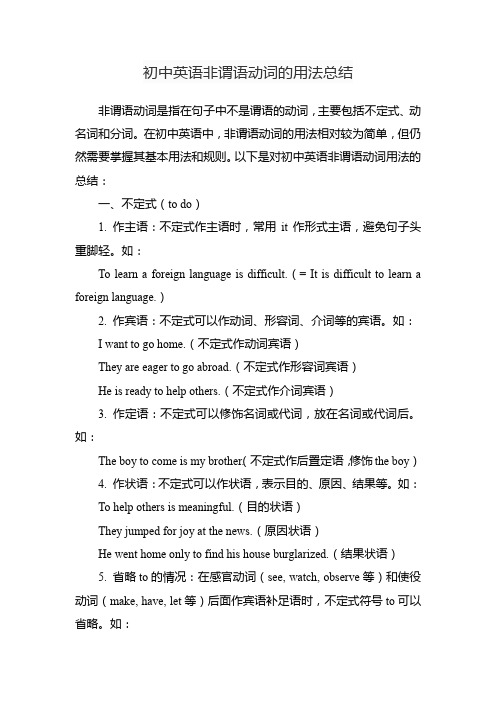
初中英语非谓语动词的用法总结非谓语动词是指在句子中不是谓语的动词,主要包括不定式、动名词和分词。
在初中英语中,非谓语动词的用法相对较为简单,但仍然需要掌握其基本用法和规则。
以下是对初中英语非谓语动词用法的总结:一、不定式(to do)1. 作主语:不定式作主语时,常用it作形式主语,避免句子头重脚轻。
如:To learn a foreign language is difficult.(= It is difficult to learn a foreign language.)2. 作宾语:不定式可以作动词、形容词、介词等的宾语。
如:I want to go home.(不定式作动词宾语)They are eager to go abroad.(不定式作形容词宾语)He is ready to help others.(不定式作介词宾语)3. 作定语:不定式可以修饰名词或代词,放在名词或代词后。
如:The boy to come is my brother.(不定式作后置定语,修饰the boy)4. 作状语:不定式可以作状语,表示目的、原因、结果等。
如:To help others is meaningful.(目的状语)They jumped for joy at the news.(原因状语)He went home only to find his house burglarized.(结果状语)5. 省略to的情况:在感官动词(see, watch, observe等)和使役动词(make, have, let等)后面作宾语补足语时,不定式符号to可以省略。
如:Let’s have him come to the party.(感官动词+不定式省略to)They had me go there.(使役动词+不定式省略to)二、动名词(doing)1. 作主语:动名词作主语时,可以直接用动名词形式,也可以用“名词+动名词”的形式。
初中英语知识点归纳非谓语动词的种类和用法
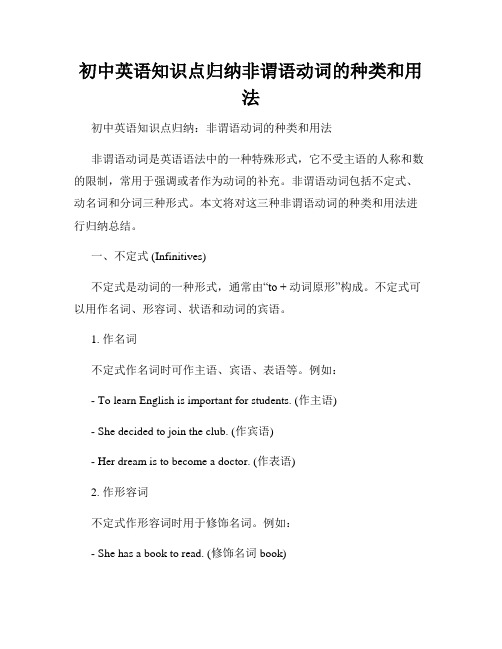
初中英语知识点归纳非谓语动词的种类和用法初中英语知识点归纳:非谓语动词的种类和用法非谓语动词是英语语法中的一种特殊形式,它不受主语的人称和数的限制,常用于强调或者作为动词的补充。
非谓语动词包括不定式、动名词和分词三种形式。
本文将对这三种非谓语动词的种类和用法进行归纳总结。
一、不定式 (Infinitives)不定式是动词的一种形式,通常由“to + 动词原形”构成。
不定式可以用作名词、形容词、状语和动词的宾语。
1. 作名词不定式作名词时可作主语、宾语、表语等。
例如:- To learn English is important for students. (作主语)- She decided to join the club. (作宾语)- Her dream is to become a doctor. (作表语)2. 作形容词不定式作形容词时用于修饰名词。
例如:- She has a book to read. (修饰名词book)不定式作状语时可以表示目的、结果、原因、条件等。
例如:- He went to the park to play basketball. (表示目的)- She studies hard to get good grades. (表示结果)- We woke up early to catch the train. (表示原因)- I need your help to finish the project. (表示条件)4. 作动词的宾语不定式可以作为动词的宾语,常见的动词有want, hope, like, love, hate等。
例如:- She wants to be a teacher when she grows up.- They hope to visit China next year.二、动名词 (Gerunds)动名词是以-ing结尾的动词形式,它可以作主语、宾语、表语、定语或者状语。
初中英语知识归纳总结——非谓语动词

初中英语知识归纳总结——非谓语动词非谓语动词(一)教学重点动词不定式在英语中,不充当句子谓语的动词,叫作非谓语动词。
由于非谓语动词不受主语的限制,没有时态和语态,所以又叫非限定动词。
非限定动词有三种形式:动词不定式;动名词和分词。
1、动词不定式(1)动词不定式的构成和性质动词不定式是一种非谓语动词,所谓非谓语动词就是不能作谓语的动词。
正因为如此,它不受主语的人称和数的限制,没有人称和数的变化,但它具有动词的某些特征,可以带宾语和状语构成不定式短语。
其构成是:“to + 动词原形”,否定式是“not to +动词原形”。
to是不定式符号,无词义。
(2)动词不定式的用法动词不定式除了不能作谓语外,可以作主语、表语、宾语、宾语补足语、定语和状语。
①作主语To learn English well is not easy.To drive fast is quite dangerous.不定式作主语时常常用it作形式主语,不定式放在谓语之后以上两个例句可以写成:It is not easy to learn English well.It is quite dangerous to drive fast.这种用法可以归纳成这样一个句型:It is (not) + 形容词+ (for sb.) to do sth.It is very expensive for me to buy a car.It is very difficult for a child to do that job.有些形容词之后跟of + 名词(代词宾语)+不定式。
如:It is very kind of you to say so.It is very good of you to come.②作表语。
如:My job is to teach English.The first thing is to ring him up.③作宾语。
初中非谓语动词最全总结[1]
![初中非谓语动词最全总结[1]](https://img.taocdn.com/s3/m/2adf2314ce84b9d528ea81c758f5f61fb6362876.png)
非谓语动词总结非谓语动词: 即, 在句子中除了充当谓语以外成分的词。
它可以分为动名词, 动词不定式, 分词。
初中着重讲前两种。
一. 后面可跟动词的ing形式的情况1.动词.finis.doin.sth.完成做某事;enjo.doin.sth.喜欢做某事;practic.doin.sth.练习做某事;imagin.doing,想象做某事;avoi.doin.sth.避免做某事;conside.doin.sth.考虑做某事;sugges.doin.sth.建议做某事;min.doin.sth.介意做某事.kee.doin.sth.持续做某事2.固定短语: feel like doing sth.喜欢做某事;be busy doing sth.忙于做某事;be worth doing 值得做某事;spend time (in) doing sth.花费时间(金钱)做某事; have difficult/trouble in doing sth做某事有困难;have fun doing.做某事高兴3.介词后(on, in, of, about, at, with, without, for, from, up, by 等)如: b.goo.a.doin.sth.;than.yo.fo.doin.sth.;giv.u.doin.sth.;sto.sb.fro.doin.sth.;d.wel.i.doin.sth.;b.afrai.o.doin.sth.;b.intereste.i.doin.sth.;b.prou.of;instea.of;b.fon.of4.to作介词的情况loo.forwar.t.doin.sth期望做某事.prefe.doin.sth.t.doin.sth与…相比较更喜欢….pa.attentio.t.doing注意做某事.be/e.t.doin.sth.习惯于做某事;mak..contributio.to为…做贡献二. 后面可跟动词的不定式形式的情况1.动词: agre.t.do同意去做;affor.t.do买得起;decid.t.do决定去做某事;hop.t.do希望去做;wis.t.do希望去做;fai.t.do做某事失败去;pla.t.do打算去做;preten.t.do假装去做.refus.t.do拒绝去做;woul.lik.t.do想要去做;wan.t.do想要去做某事;lear.t.d.学做;prefe.t.d.sth.喜欢(爱)做某事;sb.see.t.d.sth好像做某事;want/woul.lik.t.d.sth.想做……;use.t.d.sth.过去常做某事2.句型.allo.sb.t.d.sth.允许某人去做某事aske.sb.(not.t.d.sth.叫某人做事某事(叫某人不要去做某事)tel.sb.(not.t.d.sth.叫某人去(不要)做某事follo.sb.t.d.sth.跟随某人去做某事ge.sb.t.d.sth.让某人做某事war.sb.(not.t.d.sth. 警告某人做某事(或不要做某事)b.amaze.t.d.sth.对做某事感到惊讶b.afrai.t.d.sth.害怕做某事b.excite.t.d.sth.对做……感到兴.b.frightene.t.d.sth.害怕去做某事b.glad/happ.t.d.sth.高兴去做某事be/get ready to do sth.准备做某事b.sorr.t.d.sth.对做某事感到抱...b.surprise.t.d.sth.对做某事感到惊奇can’.wai.t.d.sth.迫不急待地去做某事get/hav..chanc.t.d.sth.得到一个做某事的机会It’..adj.+(fo.sb..t.d.sth.做某事(对某人来说)怎么样It’.+adj.+(o.sb..t.d.sth.I.take.sb.som.time/mone.t.d.sth.花费某人多长时间做某事It’.bes.fo.sb.t.d.sth.对某人来说做某事是最好的It’.tim.fo.sb.t.d.sth.是某人做某事的时候了too…(for sb.) to …太…以致不能… =not… enough to do =so…that prefe.t.d.sth.rathe.tha.d.sth.宁愿……而不愿……(常考)something to eat/drink 一些吃/喝的东西(动词不定式放在something 等后)Sth.i.hard/difficult/eas.t.d.做好某事很难/容易tak.turn.t.d.sth.轮流做……Ther.i.n.tim.(fo.sb..t.d.sth.对(某人来说)没时间做某事了Ther.i.n.nee.(fo.sb..t.d.sth.对某人来说没必要做某事try/d.one’.bes.t.d.sth.尽力去做某事3.动词不定式与疑问代词和疑问副词的连用。
初中英语-初中非谓语动词全总结
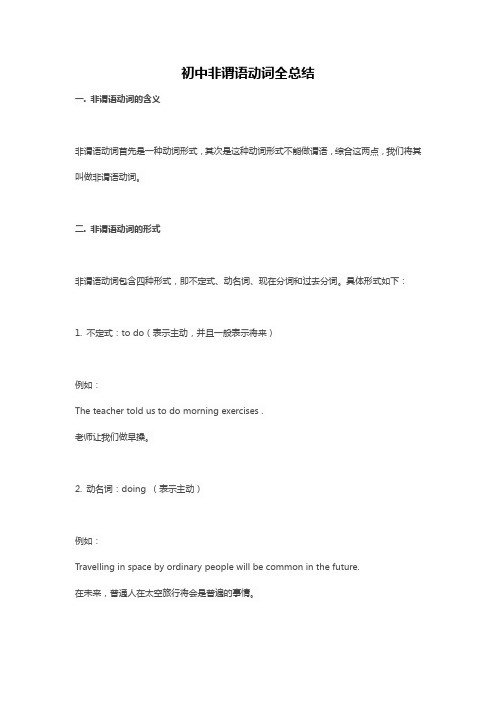
初中非谓语动词全总结一. 非谓语动词的含义非谓语动词首先是一种动词形式,其次是这种动词形式不能做谓语,综合这两点,我们将其叫做非谓语动词。
二. 非谓语动词的形式非谓语动词包含四种形式,即不定式、动名词、现在分词和过去分词。
具体形式如下:1. 不定式:to do(表示主动,并且一般表示将来)例如:The teacher told us to do morning exercises .老师让我们做早操。
2. 动名词:doing (表示主动)例如:Travelling in space by ordinary people will be common in the future.在未来,普通人在太空旅行将会是普遍的事情。
3. 现在分词:doing (表示主动和进行)例如:He sat there,reading a newspaper.他坐在那里,读着一张报纸。
4. 过去分词:done及物动词的过去分词表示被动或完成;不及物动词的过去分词表示主动或完成。
polluted river 被污染的河流(及物动词pollute和river之间是被动关系,即“河流被污染”)fallen leaves 落叶(不及物动词fall和leaves之间是主动关系,即“叶子落下来”)注意:非谓语动词本身不能表示现在和过去。
非谓语动词表示进行和将来是相对于谓语动作来说的:和谓语动作同时发生表示进行;发生在谓语动作之后表示将来三. 非谓语动词的作用非谓语动词除去不能做谓语之外,其它所有成分都可以做。
具体如下。
1. 不定式:做主语、宾语、表语、定语、状语和补语。
To learn a foreign language is difficult .(作主语)学会一门外语是很难的。
It’s easy to see their aunt.(作真正主语,it做形式主语)很容易见到他们的姑姑。
Tom wanted to have a cup of beer.(作宾语)汤姆想要喝杯啤酒。
初中知识点归纳非谓语动词的特殊用法与句型转换

初中知识点归纳非谓语动词的特殊用法与句型转换初中知识点归纳:非谓语动词的特殊用法与句型转换非谓语动词,即不具备谓语功能的动词形式,在英语语法中属于非谓语动词。
非谓语动词主要包括动词不定式、动名词和分词三种形式。
在初中英语学习中,非谓语动词的特殊用法和句型转换是一个重要的知识点。
本文将对这方面的内容进行归纳总结,并介绍一些相关的例句。
一、非谓语动词的特殊用法1. 作主语非谓语动词可以作为句子的主语,常见的形式为动词不定式和动名词。
例句:- To learn English is important for us.(不定式作主语)- Swimming is her favorite sport.(动名词作主语)2. 作宾语非谓语动词也可以作为句子的宾语,常见的形式为动词不定式和动名词。
例句:- I like to read books.(不定式作宾语)- She enjoys dancing.(动名词作宾语)3. 作表语非谓语动词有时也可以作为句子的表语,常见的形式为动词不定式和动名词。
例句:- His dream is to become a doctor.(不定式作表语)- The most important thing is learning.(动名词作表语)4. 作定语非谓语动词可以用作修饰名词的定语,常见的形式为动词不定式和动名词。
例句:- The boy who wants to be an actor is my friend.(不定式作定语)- The dancing girl is very talented.(动名词作定语)5. 作状语非谓语动词可以用作修饰动词、形容词或副词的状语,常见的形式为动词不定式、动名词和分词。
例句:- He ran to catch the bus.(不定式作状语)- The movie was so exciting that everyone kept watching.(分词作状语)二、句型转换1. 主动语态转被动语态非谓语动词在句子的主动语态和被动语态之间进行转换时,需要使用适当的被动语态结构。
初中非谓语动词用法总结

初中非谓语动词用法总结
非谓语动词是指不具有人称和数的动词形式,主要包括不定式、动名词和现在分词三种形式。
它们在句子中可以作主语、宾语、定语、状语等成分。
下面是初中非谓语动词用法的总结:
1. 不定式
不定式一般由“to + 动词原形”构成,可以表示目的、原因、结
果等。
- 作主语:To learn English well is important.
- 作宾语:I want to go shopping.
- 作定语:I have a book to read.
- 作状语:He came to help us.
2. 动名词
动名词是动词的-ing形式,可作主语、宾语、定语、状语等。
- 作主语:Swimming is good for health.
- 作宾语:She enjoys dancing.
- 作定语:He is a writing teacher.
- 作状语:She left, crying in disappointment.
3. 现在分词
现在分词一般由动词的-ing形式构成,可以作定语、状语等。
- 作定语:The running water is clear.
- 作状语:He walked out of the room, smiling.
以上是初中非谓语动词用法的简单总结,它们在句子中的具体用法多种多样,需要根据上下文和语境进行理解和运用。
通过多做练,我们可以更好地掌握非谓语动词的用法。
请注意,以上内容仅供参考,具体表达需要根据实际情况进行调整和扩展。
初中英语非谓语动词讲解

初中英语非谓语动词讲解非谓语动词是指动词在句子中不作谓语,而作其他成分或者补充说明的形式。
在英语中,非谓语动词包括动词不定式、动名词和分词。
下面将分别对这三种非谓语动词进行详细解释。
一、动词不定式(infinitive)动词不定式是以to作为标志的动词形式,通常有两种形式:一种是带有to的形式,称为带to的不定式;另一种是省略to 的形式,称为不带to的不定式。
带to的不定式的用法包括:1. 作为动词的宾语,如:She agreed to help me.2. 作为动词的补语,如:I want to be a teacher.3. 用于某些固定的动词后面,如:She promised to come early.4. 用于某些形容词后面,如:I am happy to see you.不带to的不定式的用法包括:1. 作为句子的主语,如:To learn a foreign language is important.2. 作为动词的宾语,如:She made him clean the room.3. 作为某些动词后的宾补,如:We saw him leave the house.动词不定式还有时态和语态的变化,例如:一般式:to do完成式:to have done被动式:to be done二、动名词(gerund)动名词是动词加上-ing形式构成的名词,它既具有动词的特点,又具有名词的特点。
动名词的用法包括:1. 作为动词的主语,如:Swimming is good exercise.2. 作为动词的宾语,如:I enjoy swimming in the summer.3. 作为介词的宾语,如:She is good at playing the piano.动名词也可以带有物主代词、名词性物主代词或名词作定语,如:I appreciate your helping me.三、分词(participle)分词是由动词的-ing或-ed形式构成的,它可以用作动词的形容词化形式,表示被动意义或者作为形容词修饰名词。
初中英语非谓语动词用法详解

二、A 下列动词只能带动名词作பைடு நூலகம்语:记住下面这句话,巧记共 35个多动词
Miss Rescall can enjoy five apples at dusk
Miss Rescall ----miss, mind,risk,recall ,resist Can ----can’t help, consider ,can’t resist ,complete ,can’t stand (bear) Enjoy –enjoy escape ,excuse ,endure Five –finish ,fancy feel like ,favorite(利于)imagine ,include ---advise ,avoid ,appreciate ,admit ,allow--- practise ,postpone ,pardon ,prevent ,put off dusk ---delay ,understand, suggest,keep(deny否认)
4.It’s worthwhile learning English well.5
1。直接作主语 1.To see is to believe (1)眼见为实 2.To do morning exercises today is not (2)今天早晨做早操对身体无益 good for health. (3)在这里吸烟很危险
Task: complete the following sentences
1. 2. 3. 4. 5. 6.
It‟s no use ________________( 没有用) learning without practice It’s no good ________________________________ (广说不做) talking too much without doing anything It’s necessary _____________________________( 我们学好英语) for us to learn English well It’ very kind ____________________________ (你帮助我) of you to help me How long __________________________ (你每天参加体育活动? does it take you to do sport every day Because of the heavy sand storm, ________________( 今天做晨练) to do morning exercises today is of no benefit to you.
非谓语动词用法归纳(语法)
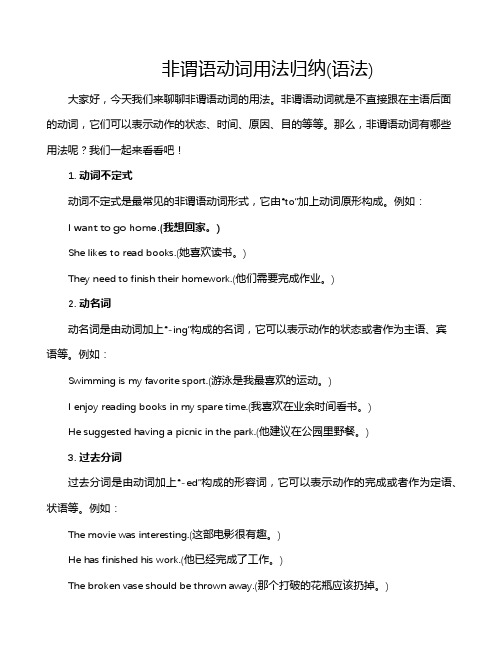
非谓语动词用法归纳(语法)大家好,今天我们来聊聊非谓语动词的用法。
非谓语动词就是不直接跟在主语后面的动词,它们可以表示动作的状态、时间、原因、目的等等。
那么,非谓语动词有哪些用法呢?我们一起来看看吧!1. 动词不定式动词不定式是最常见的非谓语动词形式,它由“to”加上动词原形构成。
例如:I want to go home.(我想回家。
)She likes to read books.(她喜欢读书。
)They need to finish their homework.(他们需要完成作业。
)2. 动名词动名词是由动词加上“-ing”构成的名词,它可以表示动作的状态或者作为主语、宾语等。
例如:Swimming is my favorite sport.(游泳是我最喜欢的运动。
)I enjoy reading books in my spare time.(我喜欢在业余时间看书。
)He suggested having a picnic in the park.(他建议在公园里野餐。
)3. 过去分词过去分词是由动词加上“-ed”构成的形容词,它可以表示动作的完成或者作为定语、状语等。
例如:The movie was interesting.(这部电影很有趣。
)He has finished his work.(他已经完成了工作。
)The broken vase should be thrown away.(那个打破的花瓶应该扔掉。
)4. 现在分词现在分词是由动词加上“-ing”构成的形容词,它可以表示动作正在进行或者作为定语、状语等。
例如:Walking in the park is good for your health.(在公园里散步对身体有好处。
)She is studying English at the moment.(她现在正在学英语。
)The running water sounds very soothing.(流水声听起来很舒缓。
初中英语知识点归纳定语从句中的非谓语动词
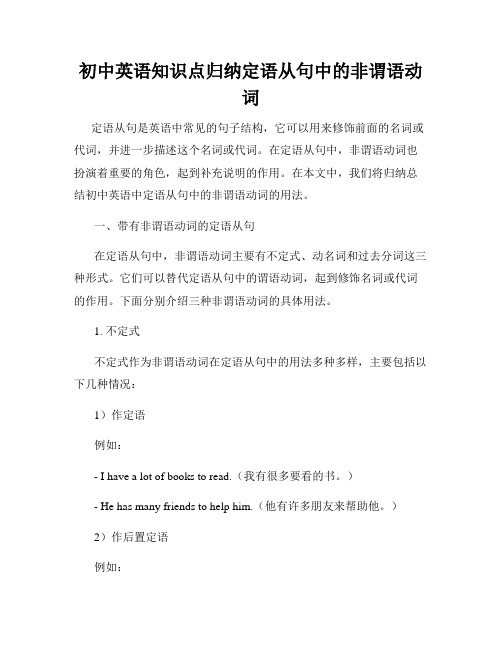
初中英语知识点归纳定语从句中的非谓语动词定语从句是英语中常见的句子结构,它可以用来修饰前面的名词或代词,并进一步描述这个名词或代词。
在定语从句中,非谓语动词也扮演着重要的角色,起到补充说明的作用。
在本文中,我们将归纳总结初中英语中定语从句中的非谓语动词的用法。
一、带有非谓语动词的定语从句在定语从句中,非谓语动词主要有不定式、动名词和过去分词这三种形式。
它们可以替代定语从句中的谓语动词,起到修饰名词或代词的作用。
下面分别介绍三种非谓语动词的具体用法。
1. 不定式不定式作为非谓语动词在定语从句中的用法多种多样,主要包括以下几种情况:1)作定语例如:- I have a lot of books to read.(我有很多要看的书。
)- He has many friends to help him.(他有许多朋友来帮助他。
)2)作后置定语例如:- They have a lot of things to do.(他们有很多事情要做。
)- She has a lot of songs to sing.(她有很多歌要唱。
)3)作状语例如:- He studies hard to learn English well.(他努力学习英语。
)- She runs every morning to keep fit.(她每天早上跑步保持健康。
)2. 动名词在定语从句中,动名词作为非谓语动词有以下几种常见的用法: 1)作定语例如:- I have a plan of going abroad.(我有一个出国的计划。
)- He told me a story about helping others.(他给我讲了一个关于帮助他人的故事。
)2)作后置定语例如:- There is no way of solving the problem.(没有解决这个问题的办法。
)- The key to passing the exam is hard work.(通过考试的关键是努力学习。
初中英语非谓语动词用法大全
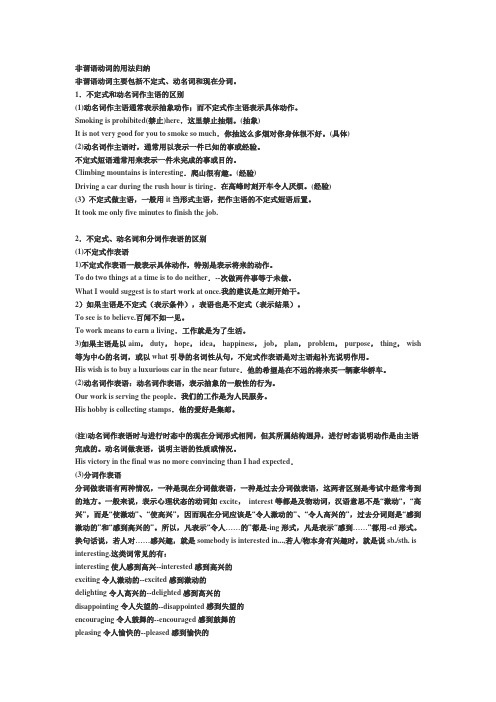
非谓语动词的用法归纳非谓语动词主要包括不定式、动名词和现在分词。
1.不定式和动名词作主语的区别(1)动名词作主语通常表示抽象动作;而不定式作主语表示具体动作。
Smoking is prohibited(禁止)here.这里禁止抽烟。
(抽象)It is not very good for you to smoke so much.你抽这么多烟对你身体很不好。
(具体)(2)动名词作主语时,通常用以表示一件已知的事或经验。
不定式短语通常用来表示一件未完成的事或目的。
Climbing mountains is interesting.爬山很有趣。
(经验)Driving a car during the rush hour is tiring.在高峰时刻开车令人厌烦。
(经验)(3)不定式做主语,一般用it当形式主语,把作主语的不定式短语后置。
It took me only five minutes to finish the job.2.不定式、动名词和分词作表语的区别(1)不定式作表语1)不定式作表语一般表示具体动作,特别是表示将来的动作。
To do two things at a time is to do neither.--次做两件事等于未做。
What I would suggest is to start work at once.我的建议是立刻开始干。
2)如果主语是不定式(表示条件),表语也是不定式(表示结果)。
To see is to believe.百闻不如一见。
To work means to earn a living.工作就是为了生活。
3)如果主语是以aim,duty,hope,idea,happiness,job,plan,problem,purpose,thing,wish 等为中心的名词,或以what引导的名词性从句,不定式作表语是对主语起补充说明作用。
His wish is to buy a luxurious car in the near future.他的希望是在不远的将来买一辆豪华轿车。
初中英语非谓语

初中英语非谓语
非谓语动词是指动词的非时态形式,包括不定式、现在分词和过去分词。
在初中英语中,非谓语动词的用法主要有以下几种:
1. 不定式:
- 作后置定语:He had a lot of work to do.(他有很多工作要做。
)
- 作主语:To learn English is important.(学好英语很重要。
) - 作宾语:I like to play basketball.(我喜欢打篮球。
)
2. 现在分词:
- 作现在分词短语作后置定语:The boy standing over there is my friend.(那边站着的男孩是我的朋友。
)
- 作和主语构成逻辑主语:Playing computer games is bad for your health.(玩电脑游戏对健康有害。
)
3. 过去分词:
- 作现在分词短语作后置定语:The books written by Dickens are very popular.(狄更斯写的书非常受欢迎。
)
- 作和主语构成逻辑主语:The window was broken by the ball.(窗户被球打破了。
)
这些都是初中英语中常见的非谓语动词用法,希望对你有帮助!。
初中非谓语动词最全总结
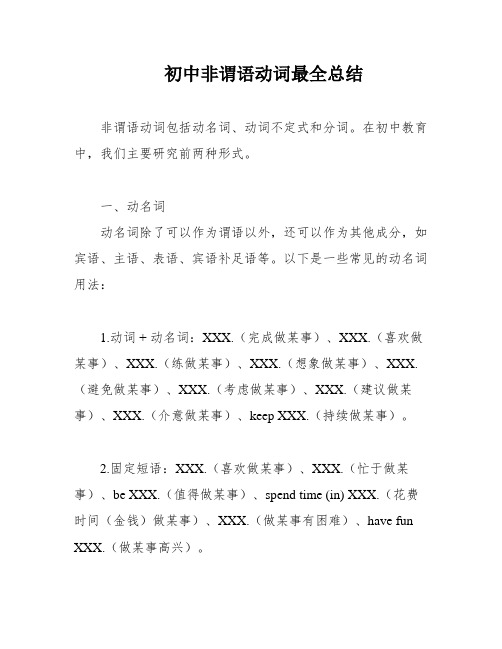
初中非谓语动词最全总结非谓语动词包括动名词、动词不定式和分词。
在初中教育中,我们主要研究前两种形式。
一、动名词动名词除了可以作为谓语以外,还可以作为其他成分,如宾语、主语、表语、宾语补足语等。
以下是一些常见的动名词用法:1.动词 + 动名词:XXX.(完成做某事)、XXX.(喜欢做某事)、XXX.(练做某事)、XXX.(想象做某事)、XXX.(避免做某事)、XXX.(考虑做某事)、XXX.(建议做某事)、XXX.(介意做某事)、keep XXX.(持续做某事)。
2.固定短语:XXX.(喜欢做某事)、XXX.(忙于做某事)、be XXX.(值得做某事)、spend time (in) XXX.(花费时间(金钱)做某事)、XXX.(做某事有困难)、have fun XXX.(做某事高兴)。
3.介词后(on。
in。
of。
about。
at。
with。
without。
for。
from。
up。
by等):be good at doing sth.(擅长做某事)、thank you for doing sth.(感谢做某事)、give up XXX.(放弃做某事)、XXX.(阻止某人做某事)、do well in doing sth.(做某事做得好)、XXX.(害怕做某事)、be XXX.(对做某事感兴趣)、be proud of(以…为自豪)、instead of(代替)、be fond of(喜爱)。
4.to作介词:look forward to doing sth.(期望做某事)、XXX.(与…相比较更喜欢…)、pay n to doing sth.(注意做某事)、be/get used to doing sth.(惯于做某事)、XXX(为…做贡献)。
二、动词不定式动词不定式通常作为动词的宾语、宾语补足语、主语、表语、定语等。
以下是一些常见的动词不定式用法:1.动词 + 不定式:decide to do sth.(决定做某事)、want to do sth.(想做某事)、XXX.(希望做某事)、try to do sth.(尝试做某事)、fail to do sth.(未能做某事)、XXX.(拒绝做某事)、promise to do sth.(承诺做某事)、manage to do sth.(设法做某事)。
初中英语语法 非谓语动词总结

初中英语语法非谓语动词总结非谓语动词主要包括不定式、动名词和现在分词。
为了区分这三种不同的非谓语动词的用法和含义,我们将分别从三种非谓语动词在句子中做主语、宾语、宾语补足语、定语、状语、表语以及一些特殊结构句型等角度来区分其用法和细微含义。
1.不定式和动名词作主语的区别(1)动名词作主语通常表示抽象动作;而不定式作主语表示具体动作。
Smoking is prohibited(禁止)here.这里禁止抽烟。
(抽象)It is not very good for you to smoke so much.你抽这么多烟对你身体很不好。
(具体)(2)动名词作主语时,通常用以表示一件已知的事或经验。
不定式短语通常用来表示一件未完成的事或目的。
Climbing mountains is interesting.爬山很有趣。
(经验)Driving a car during the rush hour is tiring.在高峰时刻开车令人厌烦。
(经验) (3)不定式做主语,一般用it当形式主语,把作主语的不定式短语后置。
It took me only five minutes to finish the job.2.不定式、动名词和分词作表语的区别(1)不定式作表语1)不定式作表语一般表示具体动作,特别是表示将来的动作。
To do two things at a time is to do neither.--次做两件事等于未做。
What I would suggest is to start work at once.我的建议是立刻开始干。
2)如果主语是不定式(表示条件),表语也是不定式(表示结果)。
To see is to believe.百闻不如一见。
To work means to earn a living.工作就是为了生活。
3)如果主语是以aim,duty,hope,idea,happiness,job,plan,problem,purpose,thing,wish等为中心的名词,或以what引导的名词性从句,不定式作表语是对主语起补充说明作用。
- 1、下载文档前请自行甄别文档内容的完整性,平台不提供额外的编辑、内容补充、找答案等附加服务。
- 2、"仅部分预览"的文档,不可在线预览部分如存在完整性等问题,可反馈申请退款(可完整预览的文档不适用该条件!)。
- 3、如文档侵犯您的权益,请联系客服反馈,我们会尽快为您处理(人工客服工作时间:9:00-18:30)。
The excited people rushed into the building. 激动的人们冲入了大楼。
作状语:分词或分词短语可以作时间、原因、方式、 结果、伴随等状语。如:
A. cry; to cry B. to cry; cry C. cry; cry
3、(2009宁波) -Look at the sun ! It' s too hot
today.
--Yes. Why not _______ your coat?
A. take off
B. take away
C. take out
动名词由动词原形+ -ing构成,与现在分词同形。 动名词既有动词的性质,有宾语和状语;也有名 词的性质,可h is bad for your health. 吃的太多对身体健康有害。
动名词和动词不定式作主语,在许多情况下可以通 用,但动名词作主语表示抽象或多次的行为,不定 式作主语往往表示具体的或一次性的动作。
作宾语补足语,一般用在see, hear, notice, feel, have等动词之后与宾语构成复合宾语。如:
I saw a dog running across the street. 我看见一只狗跑过街道。 I must have the bike repaired. 我必须找人修理自行车。
疑问词+不定式:
此结构常用在下列动词之后:tell ,teach ,know, wonder, learn ,show, find out, ask, understand 等。 如:
He taught me how to plant a tree yesterday. 他昨天教我怎样种树。
3
动名词
A. play B. played C. playing
10、(2008甘肃兰州)The headmaster said
they would have __ library___.
A. another; built B. other; built
C. another; build D. other; building
8、(2008甘肃兰州)Mary was looking
forward to ____to Kate’s birthday party.
A. inviting B. being invited
C. invite
D. be invited
9、(2008甘肃甘南州)We saw his sister
____basketball when we went to the office.
He hopes to visit the Disneyland one day. 他希望有一天能参观迪斯尼乐园。
作宾语补足语:
常用不定式作宾语补足语的动词有:want, ask, tell, help等,还有一些动词,其后的不定式不带to, 如: feel, hear, let ,make, have(叫、使、让),see, watch, notice等,help后面动词不定式可以带to,也可以 不带to。 如:
2
动词不定式
1 动词不定式的形式
肯定形式:to+动词原形。如:to write
否定形式:not to+动词原形。 如:not to write
复合结构:不定式前加for sb. 如:for him to do …
2 不定式的特点
动词不定式没有人称和数的变化,在句中不能单独 作谓语。另外,动词不定式还可以有自己的宾语, 可以用状语来修饰。 如: to learn English well
Do you often see then play football? 你常看他们踢足球吗?(全过程)
He speaks loudly to make himself heard clearly. 他大声说以便让别人听清他的话。(他的话被听)
1、(2009四川泸州). My father always asks
现在分词表示事物本身所具有的性质,意为“令 人……的”;过去分词表达由外界引起的内心活 动,意为“感到……的”。如:
the exciting news 令人兴奋的消息 the excited look 激动的表情 常用的还有: interesting/interested, tiring/tired, boring/bored.
3 不定式的用法
作主语: 不定式作主语时谓语动词要用第三人称单数。 常用it作形式主语,放在句首,而将真正的 主语放在句子后面。如:
To go diving is interesting. =It is interesting to go diving. 潜水是有趣的。
作表语:主语多是表示意图、劝告之类的名词。 如:
1 非谓语动词概述
非谓语动词是指在句中起名词、形容词或副词作 用的动词形式,而不是作谓语的动词形式。
Climbing mountain is a good exercise. (Climbing 动名词起名词作用) Do you know the man wearing a white shirt? (wearing 分词起形容词作用) He gets up early to catch the first bus. (to catch 不定式起副词作用)
His wish is to be a pilot. 他的愿望是当一名飞行员。
作宾语:常用不定式作宾语的动词有:want, wish, like, hope ,decide, help, begin (start),
agree, learn, choose, seem, fail, prepare, refuse, expect, offer ,happen等。 如:
I often hear Jim sing. 我经常听见吉姆唱歌。
作定语: 作定语的不定式要放在它所修饰的名词或代词的后 面。如果不定式是不及物动词或被修饰的是表示地 点或工具的名词,则不定式要加上相应的介词。如:
By that time there will be not enough space to stand in. 到那时可能就没有立足之地。
作表语:
My mother’s job is raising chicken. 我母亲的工作是养鸡。
作宾语:
I don’t mind listening to that story again. 我不介意再听一遍那个故事。
作定语:
Let’s join the singing group. 让我们加入合唱队吧。 a working method. 工作方法
其后常接动名词的的动词及动词词组有finish, enjoy, practice, understand, mind, keep, consider, miss, avoid(避免),suggest, admit, be worth, have difficulty/problem/trouble/fun, waste time, can’t help/can’t stop, be used to(习惯于)等。
英语动词的非谓语形式为三种:动词不定式、动 名词和分词。非谓语动词没有人称和数的变化。
中考对非谓语动词的考查主要有以下内容:动词不定式作 主语、宾语、宾语补足语;动名词作主语、宾语;分词作 定语、状语。其中动词不定式的用法是中考的一大热点, 还有it作形式主语或形式宾语来代替动词不定式也是常考句 型。考查非谓语动词多用单项选择、动词填空、句型转换、 完形填空、翻译句子等形式。
me________ too much junk food.
A. don’t eat B. not to eat C. not eat
2、(2009凉山州) Though Alex had often made
his little sister _______, today he was made
______ by his little sister.
D. take up
4、(2009浙江绍兴). – Is Jack in the library? - Maybe. I saw him ______ out with some books just now. A. going B. go C. to go D. went
5、(2008甘肃兰州)I find ____very important to learn English well because it is an international language now. A .it B. its C. that D. this
不定式与分词都可跟在某些动词之后作宾语补足语。 不定式作宾语补足语,表示动作发生的全过程;现 在分词作宾语补足语,强调动作正在发生;过去分 词作宾语补足语,则重在表示被动的概念。
When they went into the park, they saw some boys playing football. 当他们走进公园时,他们看见一些男孩在踢足球。(正在做)
6、(2008甘肃嘉峪关)Fang Fang is old enough ____to school. A. goes B. to go C. went D. go
7、(2008甘肃武陵)Sunglasses are used for ____your eyes. A. protected B .protect C. pretecting D. to protect
4
分词
分词分为现在分词和过去分词。
1 区别: 现在分词表示主动,过去分词表示被动。如:
